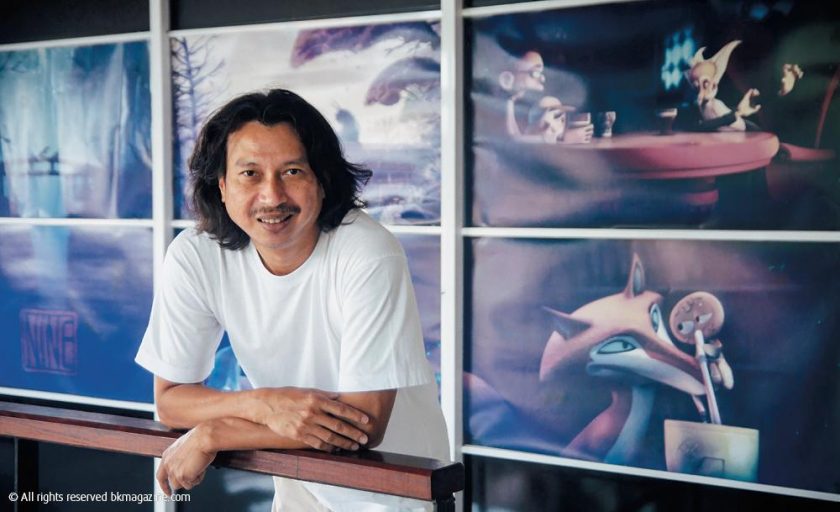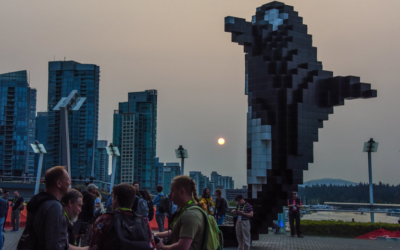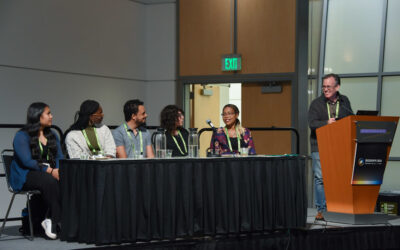Image credit: © All rights reserved bkmagazine.com
In the latest edition of the SIGGRAPH Spotlight podcast, ACM SIGGRAPH International Resources Committee member Rebecca Ko (founder, Rooftop Animation) sits down with SIGGRAPH Asia 2017 Computer Animation Festival Chair Juck Somsaman (founder, The Monk Studio) to talk about his work in animation and the upcoming SIGGRAPH Asia 2017 conference in Thailand.
Listen on SoundCloud below or subscribe to the podcast on iTunes.
FULL PODCAST TRANSCRIPT
Rebecca Ko (RK)
Can you castillos inflables tell us a little bit about yourself? What is your background, and what do you do?
Juck Somsaman (JS)
I have been in this industry since 1991. I graduated from the School of Visual Arts in New York. After that, I joined a company called Rhythm & Hues, a studio in Los Angeles, from 1991 till around 2007 when I moved back to Thailand to start The Monk Studio. The Monk Thai Studio is now 10 years old.
RK
So you have quite some experience abroad before starting The Monk. Can you compare this working experience with working in your country, abroad versus Thailand?
JS
It is quite different. When I started in Los Angeles, it was 1991, so we were pretty much in the early stages of Computer Animation. So we had to kind of figure out everything as you go. We had a big development team and programmers, and we had to kind of program and sort things out as we went along. We didn’t have any off-the-shelf tools like we have now. But all the time, things were getting more convenient with more people joining the industry, which has received a big boom over the past 25 to 26 years. Now everything has migrated. All the technology has been transferred over to Southeast Asia and Asia in general. So we have seen a big boom in the industry over in this side of the world maybe in the past 10 years. Especially in the last 5 years, there has been a big boom in China, India, Thailand, Malaysia and Korea in general. The Asian artists are now capable of producing high quality work equal to their western counterparts.
RK
Especially with China, it seems like there is more animation in films coming out last year and this year; the Annecy showcase is highlighting animated works coming out of China. So it is pretty exciting seeing that shift going from Western productions to Asian productions. What are your thoughts on it?
JS
In the past 2 years, every studio is taking on some work related to China, either Chinese work itself, or work trying to get into China from the outside. So in the past couple of years, we have had a huge quantity of Chinese productions coming into Thailand and South Asia in general. Everyone is working for China now! This is for high quality work as well, not just run-of-the-mill. This is demanding and high quality work from animated feature films and Chinese VFX, which is getting much better and demanding high quality in the past three years. It is exciting!
RK
So how do you see the future of international collaboration in your region, say for example, between Thailand and Asia and with China, U.S. and abroad?
JS
In Thailand, in general, we are doing a lot of overseas work that started with Japanese work. Now that we have reached the quality level of the industry in general, we are able to take on work from the U.S. We are starting to see a lot of big companies starting to send work to Thailand. They usually send it all over Asia like Korea, Malaysia, but now it has reached Thailand as well. This is healthy for the growth of the industry. We see an exponential growth in terms of the size of the workforce in the past 3 years.
RK
So it seems like a lot of the clients coming in are from all over the world. Is language ever a problem for this sort of collaboration?
JS
Absolutely. One of the weaknesses of Thai studios is the communication. However, nowadays, technology in studio has improved a lot, and there are management tools allowing local studios to work directly with big productions. So we see that communication is becoming less and less of an issue. Nowadays, we are looking for people who speak Chinese more than English!
RK
Would a person who spoke Chinese be valuable to the company then?
JS
They would get a job straight away!
RK
So would they also have to speak Thai to work there? Is English a common language?
JS
In the big studios, English is important and a necessity. In Monk, there are 8 or 9 producer-coordinators, and they all speak English fluently.
RK
Bringing it back to Thailand, how is the animation industry itself in Thailand, in general? Are there a lot of studios, and do they focus more on CG/VFX, or are there other sort of production houses like 2D and motion design?
JS
There has been a big boom in 3D Animation in general, and that’s the trend amongst the young people, basically. The trend is also going towards games and 3D animation more than 2D animation. Sadly, the 2D animation industry is hardly existent anymore. The big studios are trying to work in 3D. However, I personally am trying to focus on growing the 2D team, but something essential is missing in the Thai industry. We are also seeing better quality of graduates coming out of school. They are able to join productions quicker than before. Since we have a lot of TV series and high-level productions, they can jump in and join right away. Many studios are taking on western TV series jobs, which are good for training students as each series is a long-term contract with each season taking 12 to 18 months to complete. Therefore, they can take advantage of the students fresh out of school. As the VFX world is not as solid as the animation industry, we don’t see big studios taking on VFX work. Pocket studios usually take on VFX work here and there. Nowadays, as I mentioned earlier, lot of studios are doing VFX for Chinese movies, and VFX-heavy Chinese TV series like a Chinese version of Game of Thrones! China, in general, is more focused on animation than VFX.
RK
In Hong Kong, it is quite the reverse with studios producing VFX work for commercials and films. There isn’t a lot of original animated content.
JS
Animated content requires a bigger team with a huge number of people. We are starting to see studios with more than 100 people, which is a good sign for the industry. Eventually, after a few years doing TV series, studios would want to move to feature films. Therefore, there are more studios doing feature work recently as they gain more experience and get better and faster.
RK
Monk Studios have produced their own independent work before as well like the “Escape of the gingerbread Man” and “Nine”. How do you feel about creating your own content like films and shorts?
JS
We have built our core team in order to create our own content. Our goal is to be able to keep releasing our own original content. So far we have released two short films, and we are working on developing features and we are hoping we can launch it soon, which is a long-term goal. In the meantime, we will take on work for hire and keep paying the bills! I think Thai people in general, especially the local talent, are very creative. Thailand has a good proportion of post-production houses, and they are well known for live action commercials. The Thai film industry is quite small, but we do have a lot of creative people in the film business around us like editors, writers, and directors. Combining the traditional filmmaker and animation, we have a very good environment for creating new content. The community is very helpful as well. If I need a writer, I can make a few phone calls and would get a list of local writers available for the job. As I said, we have good post-production facilities in Thailand that we are known for, like DI (Digital Intermediate) and sound studios within a reasonable budget that is helpful for animation work as well. So with a combination of all these, we can build our own self-sufficient environment for us to create our own creative work.
RK
Asian studios have the advantage of creating content with a lower budget than Hollywood productions in the West. Would you also say that your own culture is another advantage?
JS
We have our own stories to tell, like kids have their own local bedtime stories. So that could be part of the advantage for the storytelling environment. What is missing is government support for the industry, which is quite important. Our neighboring countries have government incentives supporting the industry. So as part of the local committee for Animation Association, we are trying to push for these incentives from the government.
RK
How is the Government’s attitude towards supporting the industry?
JS
They are getting better, and they are aiming to understand the creative media industry better. We have been seeing Thai films in international venues like Cannes or Annecy, and this year is the first year that there has been incentives for live-action films where they received some tax rebate. I am hoping that in the near future, we will have these types of incentives for the animation industry as well. So there are people within the industry trying to push for this in order for us to be able to take on big productions and also expand the local industry. It hopefully will happen in the next 5 years.
RK
How did you first get involved with SIGGRAPH?
JS
I knew of SIGGRAPH since 1991. My student film short was selected for the Animation Theater back then. Since I was in LA, I was able to attend SIGGRAPH since then, almost every year. My old company used to throw a very good SIGGRAPH party, which was not to miss! We will try to do the same here as well with the Monk Studio throwing a big SIGGRAPH party!
RK
Have you worked with international communities before SIGGRAPH?
JS
When I moved back to Thailand in 2007, the local chapter in Bangkok approached me, and I joined them 5 or 6 years ago. We have a meeting every now and then to organize something in Bangkok or in Thailand. This led to us organizing SIGGRAPH Asia in Bangkok this year, which was a big achievement for the local community. We are very proud of it, and we are hoping it will be a good one and start a regular SIGGRAPH Asia in Bangkok!
RK
Can you tell us a little bit about your experience working as the chair of the Computer Animation Festival (CAF) this year at SIGGRAPH Asia Bangkok?
JS
I was invited to be part of the CAF Committee last year for Macau, which was my first experience being part of the CAF. It was very exciting, and I got to meet a lot of people in local illustration. We did the screening and jury for the Electronic theater, which is what we will be doing in Bangkok as well. We are currently in the process of selecting the jury and reviewers for the CAF, and we hope that we can create a good program this year.
RK
How was the curation process? Was there something you looked for in particular in the submissions?
JS
The committee is made of the a wide range of people. We have co-chair Prashant Buyyala, who is a champion everywhere and has worked in Rhythm & Hues, Dreamworks and Dreamworks Oriental in China. He knows a lot about the people in the business, and we have a good group of people from not just Thailand, but internationally. The team is great, and we love working together. It is exciting! In terms of curation, we are focusing on initially not being a copy of SIGGRAPH U.S., and having our own flavor. We are focusing on Asian content in general with work translation, artist translation, and approaching studios and artists to submit work for this year, including students in China, India, Thailand, Malaysia, Korea.
RK
Therefore, will the upcoming CAF will be more focused on Asia both creator and content wise?
JS
It would not be fair to just focus on Asia, as we are open to everyone. However, there will be an Asian flavor to the program.
RK
Can you please give us one fun fact about your country for the people visiting SIGGRAPH Asia Bangkok this year? Is there anything in particular you would recommend people to try?
JS
Thailand and Bangkok are number-one tourist destinations, so people would want to be here in the first place. We are friendly people, and there are a lot of things to do outside, apart from the excitement of SIGGRAPH itself. Transport, accommodation, and all other services are convenient and not expensive. You will have a lot of fun! Try Thai food! It is great to be able to have authentic Thai food when you are here. SIGGRAPH itself is very exciting, and it will be a good program that I’m looking forward to attend as we have a lot of things to show that every chair and committee is working hard to create a good show! We welcome everyone to come attend SIGGRAPH this year!



